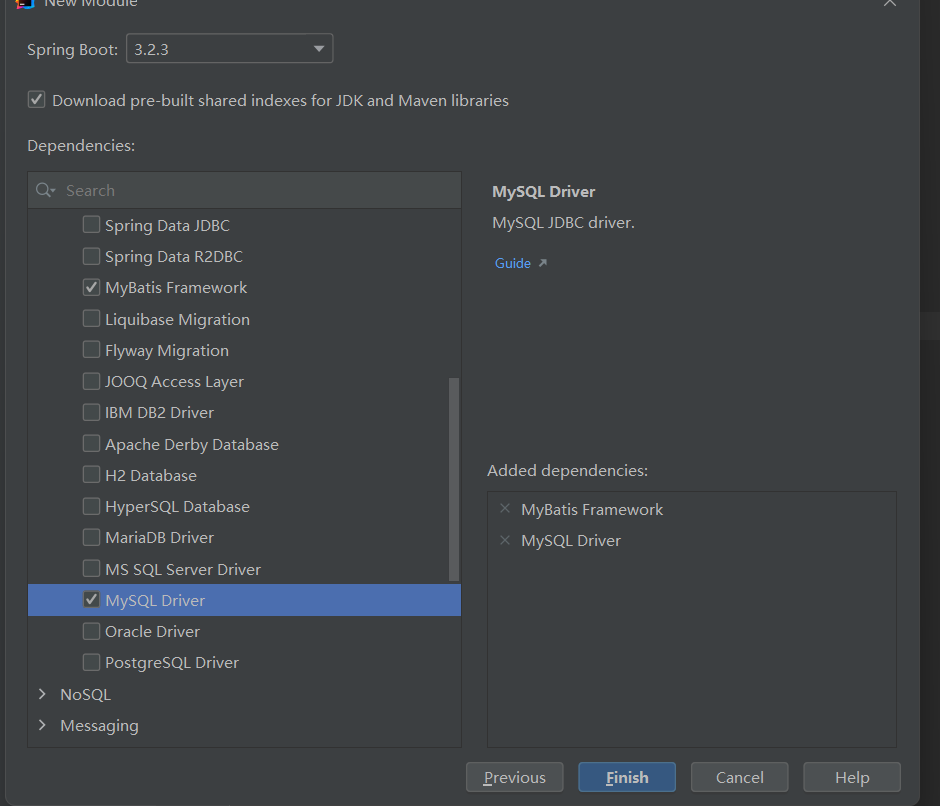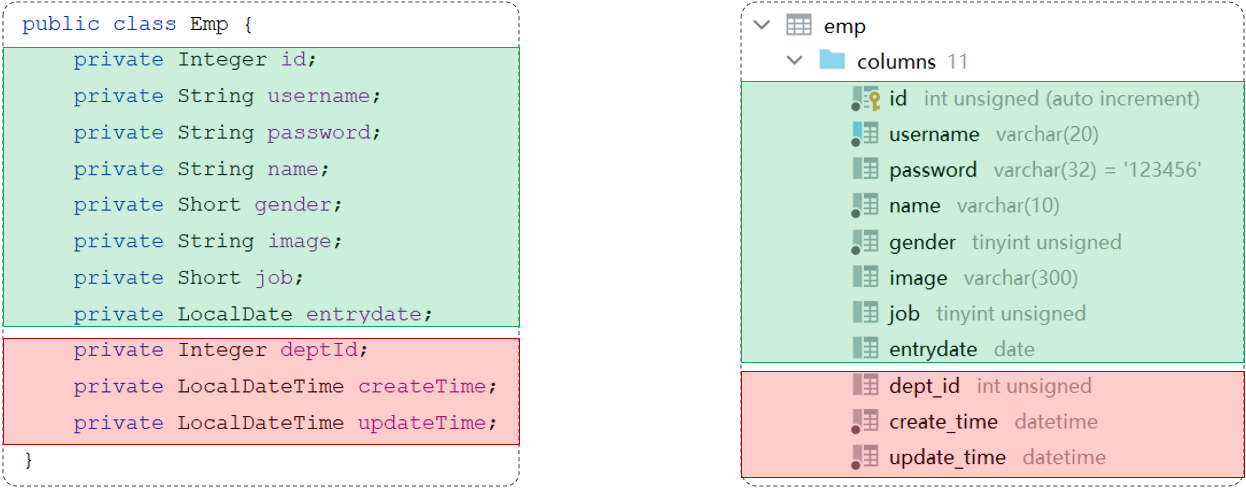Mybatis
快速创建

-
创建springboot工程(Spring Initializr),并导入 mybatis的起步依赖、mysql的驱动包。创建用户表user,并创建对应的实体类User

-
在springboot项目中,可以编写main/resources/application.properties文件,配置数据库连接信息。
#驱动类名称 spring.datasource.driver-class-name=com.mysql.cj.jdbc.Driver #数据库连接的url spring.datasource.url=jdbc:mysql://localhost:3306/mybatis #连接数据库的用户名 spring.datasource.username=root #连接数据库的密码 spring.datasource.password=1234 -
在引导类所在包下,在创建一个包 mapper。在mapper包下创建一个接口 UserMapper

@Mapper注解:表示是mybatis中的Mapper接口
-程序运行时:框架会自动生成接口的实现类对象(代理对象),并交给Spring的IOC容器管理
@Select注解:代表的就是select查询,用于书写select查询语句
@Mapper
public interface UserMapper {
//查询所有用户数据
@Select("select * from user")
public List<User> list();
}
数据库连接池
数据库连接池是一个容器,负责管理和分配数据库连接(Connection)。
- 在程序启动时,连接池会创建一定数量的数据库连接。
- 客户端在执行 SQL 时,从连接池获取连接对象,执行完 SQL 后,将连接归还给连接池,以供其他客户端复用。
- 如果连接对象长时间空闲且超过预设的最大空闲时间,连接池会自动释放该连接。
优势:避免频繁创建和销毁连接,提高数据库访问效率。
Druid(德鲁伊)
-
Druid连接池是阿里巴巴开源的数据库连接池项目
-
功能强大,性能优秀,是Java语言最好的数据库连接池之一
把默认的 Hikari 数据库连接池切换为 Druid 数据库连接池:
-
在pom.xml文件中引入依赖
<dependency> <!-- Druid连接池依赖 --> <groupId>com.alibaba</groupId> <artifactId>druid-spring-boot-starter</artifactId> <version>1.2.8</version> </dependency> -
在application.properties中引入数据库连接配置
spring.datasource.druid.driver-class-name=com.mysql.cj.jdbc.Driver spring.datasource.druid.url=jdbc:mysql://localhost:3306/mybatis spring.datasource.druid.username=root spring.datasource.druid.password=123456
SQL注入问题
SQL注入:由于没有对用户输入进行充分检查,而SQL又是拼接而成,在用户输入参数时,在参数中添加一些SQL关键字,达到改变SQL运行结果的目的,也可以完成恶意攻击。
在Mybatis中提供的参数占位符有两种:${...} 、#{...}
-
#{...}
- 执行SQL时,会将#{…}替换为?,生成预编译SQL,会自动设置参数值
- 使用时机:参数传递,都使用#{…}
-
${...}
- 拼接SQL。直接将参数拼接在SQL语句中,存在SQL注入问题
- 使用时机:如果对表名、列表进行动态设置时使用
日志输出
只建议开发环境使用:在Mybatis当中我们可以借助日志,查看到sql语句的执行、执行传递的参数以及执行结果
-
打开application.properties文件
-
开启mybatis的日志,并指定输出到控制台
#指定mybatis输出日志的位置, 输出控制台
mybatis.configuration.log-impl=org.apache.ibatis.logging.stdout.StdOutImpl
驼峰命名法
在 Java 项目中,数据库表字段名一般使用 下划线命名法(snake_case),而 Java 中的变量名使用 驼峰命名法(camelCase)。
-
小驼峰命名(lowerCamelCase):
-
第一个单词的首字母小写,后续单词的首字母大写。
-
例子:
firstName,userName,myVariable
大驼峰命名(UpperCamelCase):
- 每个单词的首字母都大写,通常用于类名或类型名。
- 例子:
MyClass,EmployeeData,OrderDetails
表中查询的数据封装到实体类中
- 实体类属性名和数据库表查询返回的字段名一致,mybatis会自动封装。
- 如果实体类属性名和数据库表查询返回的字段名不一致,不能自动封装。

解决方法:
- 起别名
- 结果映射
- 开启驼峰命名
- 属性名和表中字段名保持一致
开启驼峰命名(推荐):如果字段名与属性名符合驼峰命名规则,mybatis会自动通过驼峰命名规则映射
驼峰命名规则: abc_xyz => abcXyz
- 表中字段名:abc_xyz
- 类中属性名:abcXyz
推荐的完整配置:
mybatis:
#mapper配置文件
mapper-locations: classpath:mapper/*.xml
type-aliases-package: com.sky.entity
configuration:
#开启驼峰命名
map-underscore-to-camel-case: true
type-aliases-package: com.sky.entity把 com.sky.entity 包下的所有类都当作别名注册,XML 里就可以直接写 <resultType="Dish"> 而不用写全限定名。可以多添加几个包,用逗号隔开。
增删改
- 增删改通用!:返回值为int时,表示影响的记录数,一般不需要可以设置为void!
作用于单个字段
@Mapper
public interface EmpMapper {
//SQL语句中的id值不能写成固定数值,需要变为动态的数值
//解决方案:在delete方法中添加一个参数(用户id),将方法中的参数,传给SQL语句
/**
* 根据id删除数据
* @param id 用户id
*/
@Delete("delete from emp where id = #{id}")//使用#{key}方式获取方法中的参数值
public void delete(Integer id);
}

上图参数值分离,有效防止SQL注入
作用于多个字段
@Mapper
public interface EmpMapper {
//会自动将生成的主键值,赋值给emp对象的id属性
@Options(useGeneratedKeys = true,keyProperty = "id")
@Insert("insert into emp(username, name, gender, image, job, entrydate, dept_id, create_time, update_time) values (#{username}, #{name}, #{gender}, #{image}, #{job}, #{entrydate}, #{deptId}, #{createTime}, #{updateTime})")
public void insert(Emp emp);
}
在 @Insert 注解中使用 #{} 来引用 Emp 对象的属性,MyBatis 会自动从 Emp 对象中提取相应的字段并绑定到 SQL 语句中的占位符。
@Options(useGeneratedKeys = true, keyProperty = "id") 这行配置表示,插入时自动生成的主键会赋值给 Emp 对象的 id 属性。
// 调用 mapper 执行插入操作
empMapper.insert(emp);
// 现在 emp 对象的 id 属性会被自动设置为数据库生成的主键值
System.out.println("Generated ID: " + emp.getId());
查
查询案例:
- 姓名:要求支持模糊匹配
- 性别:要求精确匹配
- 入职时间:要求进行范围查询
- 根据最后修改时间进行降序排序
重点在于模糊查询时where name like '%#{name}%' 会报错。
解决方案:
使用MySQL提供的字符串拼接函数:concat('%' , '关键字' , '%')
CONCAT() 如果其中任何一个参数为 NULL,CONCAT() 返回 NULL,Like NULL会导致查询不到任何结果!
NULL和''是完全不同的
@Mapper
public interface EmpMapper {
@Select("select * from emp " +
"where name like concat('%',#{name},'%') " +
"and gender = #{gender} " +
"and entrydate between #{begin} and #{end} " +
"order by update_time desc")
public List<Emp> list(String name, Short gender, LocalDate begin, LocalDate end);
}
XML配置文件规范
使用Mybatis的注解方式,主要是来完成一些简单的增删改查功能。如果需要实现复杂的SQL功能,建议使用XML来配置映射语句,也就是将SQL语句写在XML配置文件中。
在Mybatis中使用XML映射文件方式开发,需要符合一定的规范:
-
XML映射文件的名称与Mapper接口名称一致,并且将XML映射文件和Mapper接口放置在相同包下(同包同名)
-
XML映射文件的namespace属性为Mapper接口全限定名一致
-
XML映射文件中sql语句的id与Mapper接口中的方法名一致,并保持返回类型一致。

<select>标签:就是用于编写select查询语句的。
resultType属性,指的是查询返回的单条记录所封装的类型(查询必须)。
parameterType属性(可选,MyBatis 会根据接口方法的入参类型(比如 Dish 或 DishPageQueryDTO)自动推断),POJO作为入参,需要使用全类名或是type‑aliases‑package: com.sky.entity 下注册的别名。
<insert id="insert" useGeneratedKeys="true" keyProperty="id">
<select id="pageQuery" resultType="com.sky.vo.DishVO">
<select id="list" resultType="com.sky.entity.Dish" parameterType="com.sky.entity.Dish">
实现过程:
-
resources下创与java下一样的包,即edu/whut/mapper,新建xx.xml文件
-
配置Mapper文件
<?xml version="1.0" encoding="UTF-8" ?> <!DOCTYPE mapper PUBLIC "-//mybatis.org//DTD Mapper 3.0//EN" "https://mybatis.org/dtd/mybatis-3-mapper.dtd"> <mapper namespace="edu.whut.mapper.EmpMapper"> <!-- SQL 查询语句写在这里 --> </mapper>namespace属性指定了 Mapper 接口的全限定名(即包名 + 类名)。 -
编写查询语句
<select id="list" resultType="edu.whut.pojo.Emp"> select * from emp where name like concat('%',#{name},'%') and gender = #{gender} and entrydate between #{begin} and #{end} order by update_time desc </select>id="list":指定查询方法的名称,应该与 Mapper 接口中的方法名称一致。resultType="edu.whut.pojo.Emp":resultType只在 查询操作 中需要指定。指定查询结果映射的对象类型,这里是Emp类。
这里有bug!!!
concat('%',#{name},'%')这里应该用<where> <if>标签对name是否为NULL或''进行判断
动态SQL
SQL-if,where
<if>:用于判断条件是否成立。使用test属性进行条件判断,如果条件为true,则拼接SQL。
<if test="条件表达式">
要拼接的sql语句
</if>
<where>只会在子元素有内容的情况下才插入where子句,而且会自动去除子句的开头的AND或OR,加了总比不加好
<select id="list" resultType="com.itheima.pojo.Emp">
select * from emp
<where>
<!-- if做为where标签的子元素 -->
<if test="name != null">
and name like concat('%',#{name},'%')
</if>
<if test="gender != null">
and gender = #{gender}
</if>
<if test="begin != null and end != null">
and entrydate between #{begin} and #{end}
</if>
</where>
order by update_time desc
</select>
SQL-foreach
Mapper 接口
@Mapper
public interface EmpMapper {
//批量删除
public void deleteByIds(List<Integer> ids);
}
XML 映射文件
<foreach> 标签用于遍历集合,常用于动态生成 SQL 语句中的 IN 子句、批量插入、批量更新等操作。
<foreach collection="集合名称" item="集合遍历出来的元素/项" separator="每一次遍历使用的分隔符"
open="遍历开始前拼接的片段" close="遍历结束后拼接的片段">
</foreach>
open="(":这个属性表示,在生成的 SQL 语句开始时添加一个 左括号 (。
close=")":这个属性表示,在生成的 SQL 语句结束时添加一个 右括号 )。
例:批量删除实现
<delete id="deleteByIds">
DELETE FROM emp WHERE id IN
<foreach collection="ids" item="id" separator="," open="(" close=")">
#{id}
</foreach>
</delete>
实现效果类似:DELETE FROM emp WHERE id IN (1, 2, 3);
